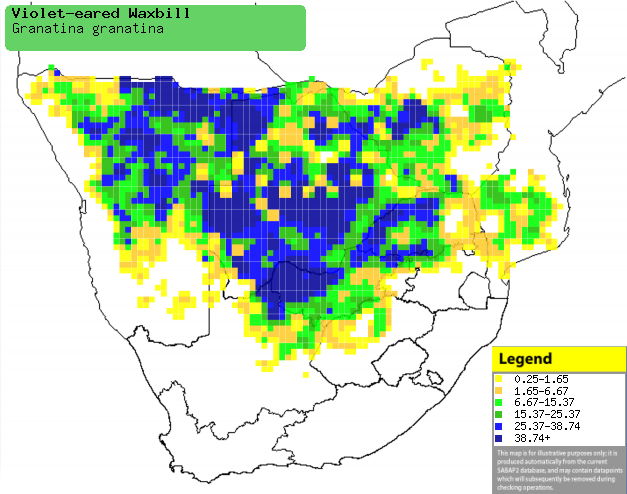|
Granatina granatina
(Violet-eared waxbill)
[= Uraeginthus granatinus]
Koningblousysie [Afrikaans]; Katjikilili (applied to some
of waxbills and twinspots) [Kwangali]; Xindzingiri bhanga (also applied to
Common waxbill and Green-winged pytilia) [Tsonga]; Granaatastrild common
[Dutch]; Cordonbleu grenadin [French]; Granatastrild, Blaubäckchen
[German]; Monsenhor [Portuguese]
Life
> Eukaryotes >
Opisthokonta
> Metazoa (animals) >
Bilateria >
Deuterostomia > Chordata >
Craniata > Vertebrata (vertebrates) > Gnathostomata (jawed
vertebrates) > Teleostomi (teleost fish) > Osteichthyes (bony fish) > Class:
Sarcopterygii (lobe-finned
fish) > Stegocephalia (terrestrial
vertebrates) > Tetrapoda
(four-legged vertebrates) > Reptiliomorpha > Amniota >
Reptilia (reptiles) >
Romeriida > Diapsida > Archosauromorpha > Archosauria >
Dinosauria
(dinosaurs) > Saurischia > Theropoda (bipedal predatory dinosaurs) >
Coelurosauria > Maniraptora >Aves
(birds) > Order: Passeriformes
> Family: Estrildidae
Distribution and habitat
Near-endemic to southern Africa, occurring from southern
Angola and Zambia to Namibia, Botswana, western Zimbabwe and northern South
Africa, while more scarce in southern Mozambique and eastern Zimbabwe. It
generally prefers shrub thickets, open Kalahari Acacia woodland, clumps
of Mopane (Colosphermum mopane) in broad-leaved woodland and stands of
Zambezi teak (Baikiaea plurijuga) with Sand Camwood (Baphia
massaiensis) and Bauhinia scrub.
|
 |
|
Distribution of Violet-eared waxbill in southern
Africa, based on statistical smoothing of the records from first SA Bird
Atlas Project (©
Animal Demography unit, University of
Cape Town; smoothing by Birgit Erni and Francesca Little). Colours range
from dark blue (most common) through to yellow (least common).
See here for the latest distribution
from the SABAP2. |
Food
It mainly eats seeds take directly from grasses or from the
ground, supplemented with insects hawked aerially or plucked from the soil. It
does most of its foraging in the morning and in the early evening, generally
staying in shade to avoid the heat of the sun (especially in the Kalahari). The following food items have been recorded
in its diet:
- Plants
- seeds
- grass
- Aristida
- A. adscensionis (Annual bristle grass)
- A. congesta (Prickle grass)
- A. scabrivalis (Pers steekgras)
- Brachiaria nigropedata (Spotted signal grass)
- Cenchrus ciliaris (Buffelsgras)
- Chloris pycnothrix (Chloris)
- Digitaria argyrigrapta (Silver finger grass)
- Eragrostis barbinodis (Cane beardgrass)
- Eragrostis lehmanniana (Lehmann's lovegrass)
- Melinis repens (Natal redtop)
- Panicum gilvum (Panic)
- Panicum maximum (Guinea grass)
- Setaria pallide-fusca (Garden bristle grass)
- Setaria vericillata (Hooked bristlegrass)
- Tragus berteronianus (Small carrot-seed grass)
- Tricholaena monachne (Blousaadgras)
- Trichoneura grandiglumis (Rolling grass)
- Urochloa mosambicensis (Common uruchloa)
- forbs
- Alternanthera pungens (Khakiweed)
- Portulaca oleracea (Bobbejaandraad)
- fruit
- Boscia albitrunca (Shepherds-tree)
- Carissa bispinosa (Num-num)
- Asparagus
- nectar
- Aloe greatheadii (Spotted aloe)
- Insects
Breeding
- Monogamous, solitary nester with a life-long pair bond.
- The nest is built by both sexes, consisting of a thick-walled, vertical
oval-shaped structure made of mainly grass stems, the ends of which stick
out untidily. The interior is lined with green grass inflorescences and
feathers of other birds. It is typically concealed in the foliage of a shrub
or tree, such as Acacia, Boscia albitrunca (Sheperds-tree),
Combretum apiculatium (Red bushwillow), Dicrostachys cinerea
(Sickle-bush), Uclea (guarris), Grewia flava (Velvet raisin)
and Maytenus (spike-thorns).
- Egg-laying season is almost year round, peaking after summer rainfall
when grass inflorescences sprout, from December-May.
- It lays 2-7 eggs, which are incubated by both sexes for about 12-13
days.
- The chicks are fed and brooded by both adults, leaving the nest after
about 16-18 days.
Threats
Not threatened, although it is in demand in Mozambique for
the cage-bird trade, however its nomadic movements prevent excessive trapping.
References
-
Hockey PAR, Dean WRJ and Ryan PG 2005. Roberts
- Birds of southern Africa, VIIth ed. The Trustees of the John Voelcker
Bird Book Fund, Cape Town.
|
